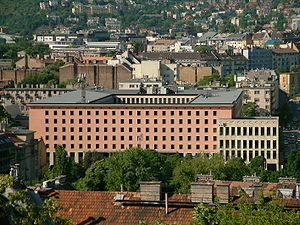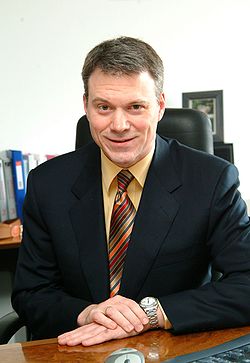- Magyar Telekom
-
Magyar Telekom Type Joint-stock company Industry telecommunications Founded 1991 Headquarters Budapest, Hungary Key people Christopher Mattheisen, CEO Products Fixed telephony, Mobile telephony, Broadband, Internet services, IT/Network services Revenue  €2,539.8 million (2006) [1]
€2,539.8 million (2006) [1]Net income  €290.1 million (2006)
€290.1 million (2006)Employees 12,300 (December, 2006) Website Magyar Telekom 
Headquarters of Magyar Telekom in Budapest 
Christopher Mattheisen
Magyar Telekom's Chief Executive OfficerMagyar Telekom Nyrt. (Magyar Telekom Távközlési Részvénytársaság – Hungarian Telekom Telecommunications PLC.) is Hungary's largest telecommunications company. The former monopolist is now a fully consolidated subsidiary of Deutsche Telekom. Until May 6, 2005, it was (and informally still is) known as MATÁV (Magyar Távközlési Rt. - Hungarian Telecommunications PLC.). The company was formed under the name of Magyar Távközlési Vállalat (Hungarian Telecommunications Enterprise) in December, 1989, when Magyar Posta (Hungarian Post) was split to three separate enterprises. On December 31, 1991, the company was re-structured as a Public Limited Company, as Magyar Távközlési Rt., and the company remained in 100% state ownership until the end of 1993. On July 1, 1993 the Telecommunications Act came into effect, and now it was possible to privatise the company. A consortium was formed by Deutsche Telekom and Ameritech International, which was named MagyarCom, and bought into the company a share of 30.1% for a price of 875 million USD.
Contents
Company Group
The Magyar Telekom Group covers three business areas: wireline services, mobile communications, services provided to business customers. The further members of the Magyar Telekom Group in Hungary are the following:
- T-Home (fusion of T-Com, T-Online and T-Kábel)
- T-Mobile (formerly Westel 900, later Westel)
- T-Systems (formerly Matáv Üzleti Szolgáltatások Üzletág)
International Companies
The Magyar Telekom Group’s strategy is to strengthen its footprint in the South-Eastern European telecommunications market. By the end of 2006 the telecom holds substantial shares in companies:
- Makedonski Telekom - Macedonia
- T-Mobile Macedonia - Macedonia
- T-Crnogorski Telekom - Montenegro
- T-Mobile Crna Gora (formerly MoNet)
- Combridge - Romania
Development projects
NGN based developments
Magyar Telekom have been working on several subjects, one of them is the ENUM (tElephone NUmber Mapping) project. In the frame of the project is elaborated such a pilot ENUM system, which allows assigning ENUM identifiers to users and accessing the ENUM users at several, different addresses. A Web-based GUI (Graphical User Interface) is provided both for the administration and the managing of user profiles. Many investigations in the signaling protocols of 3G mobile networks are made to amalgamate geographical mobility and dynamically distributable relatively high bandwidth with the wide range of next generation services. In the field of IP telephony services and applications they have already implemented the integration of hardware-based telephones. They have elaborated such a QoS measuring method, with the help of which the quality of the VoIP (Voice over IP) service can be tested and measured on a relative scale, and the given test results can be compared.
A special case of mobility is the so called nomadic mobility, when the user - who is on the move - is not connected to the network. An average laptop user can hardly concentrate on his work, while he is on the way. He needs network connection only when he stopped and can pull out his laptop from his bag. For instance, such typical places of temporary, nomadic presence are the public WLAN Hot spots located in airports or cafeterias, or connection points made available by companies for their business partners visiting them. In the course of our developments Magyar Telekom have been analyzing the possibilities of providing VoIP connection for such "wandering" subscribers.
WiMax developments
Magyar Telekom has already announced its new WiMax technology based service. In the interest of it, they have created a test environment on which the system integration and functional tests can be carried out prior to general rollout.
xDSL technologies
The traditional twisted copper pair continues to be a determinant element of access networks. Systems of the past have been improved in efficiency through numerous innovations and the appearing newer and newer technologies offer further possibilities for the providers. In the frame of this research we have been analyzing the possibilities of new generation xDSL technologies (ADSL2, ADSL2+, SHDSL, VDSL2). Achievable bandwidth, reachable distance and the triple-play related features of equipment are in the focus of the tests. Moreover, we carry out analyses and measurements to identify the conditions of system integration of DSLAM-s with Ethernet uplink. The purpose of the research works is to enable for Magyar Telekom to determine already in the early phase of technological developments those solutions that can provide broadband access for the future's advanced services.
Optical systems
In high speed (10, 40 Gbit/s) DWDM systems, especially in pure optical networks, the optimum location of the optical amplifiers and the dispersion compensating elements to a great extent influences the performance (throughput) capabilities of the network. At the same time, an exact and accurate calculation method giving the optimum for the location based on the physical parameters of the network and the active elements, is not yet available. The R&D theme has the purpose to explore the mentioned interrelations and through practical measurements to verify and correct the theoretical results. In the frame of this research work we are searching for those practicable calculation and dimensioning methods that can be manufacturer, vendor or system independently applied for the 'physical' networks.
External links
Econet · Egis Rt. · FHB Mortgage Bank · Fotex · Magyar Telekom · MOL · OTP Bank · PannErgy · RFV · Rába · Gedeon Richter Ltd. · TVK
Categories:- Deutsche Telekom
- Telecommunications companies of Hungary
Wikimedia Foundation. 2010.


